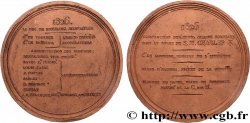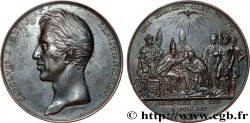Live auction - fme_1042783 - CHARLES X Médaille, Palais de la Bourse
You must signin and be an approved bidder to bid, LOGIN TO BID. Accounts are subject to approval and the approval process takes place within 48 hours. Do not wait until the day a sale closes to register. Clicking on "BID" constitutes acceptance of the terms of use of cgb.fr private live auctions.
Bids must be placed in whole Euro amounts only. The sale will start closing at the time stated on the item description; any bids received at the site after the closing time will not be executed. Transmission times may vary and bids could be rejected if you wait until the last second. For further information check the Live auction FAQ
All winning bids are subject to a 18% buyer’s fee.
All winning bids are subject to a 18% buyer’s fee.
Type : Médaille, Palais de la Bourse
Date: 1825
Mint name / Town : 75 - Paris
Metal : bronze
Diameter : 67,5 mm
Orientation dies : 12 h.
Engraver PETIT Louis-Michel (1791-1844)
Weight : 140,81 g.
Edge : lisse
Puncheon : sans poinçon
Coments on the condition:
Jolie patine marron hétérogène avec quelques taches d’oxydation. Présence de quelques coups et rayures. Petite usure
Catalogue references :
Obverse
Obverse legend : LOUIS XVIII - CHARLES X.
Obverse description : Bustes accolés à gauche de Louis XVIII et de Charles X. Signé : PETIT F..
Reverse
Reverse legend : PALAIS DE LA BOURSE ET DU TRIB.AL DE COMM.CE / ACHEVÉ EN 1825.
Reverse description : La ville de Paris assise à droite remet les clés à Mercure, devant le Palais de la Bourse de commerce ; légende en deux lignes à l’exergue.
Commentary
Le palais Brongniart, anciennement appelé palais de la Bourse, est un édifice entouré d'un péristyle de style corinthien, qui accueillait la Bourse de Paris. Il est situé dans le quartier Vivienne, dans le 2e arrondissement de Paris. Il a été conçu par l’architecte Alexandre-Théodore Brongniart (1739-1813).
En 1807, Napoléon 1er confie la construction d’un édifice à l’architecte Alexandre-Théodore Brongniart (1739-1813). Il souhaite mettre en place un emblème de la puissance et de l’accomplissement auxquels la France est parvenue. En effet, les triomphes de l’empereur sur les champs de bataille développent un véritable commerce européen. Il commande en 1808 à l’architecte Alexandre-Théodore Brongniart un édifice à l’effigie du commerce : la Bourse de Paris. L’empereur espère ainsi instaurer un ordre dans l’économie du pays en centralisant l’ensemble des échanges économiques.
Cependant, A.T. Brongniart n’eut pas la possibilité de voir son œuvre achevée, mourant prématurément le 6 juin 1813.
Parmi les candidats à la reprise du projet, on compte François-Joseph Bélanger et Louis-Pierre Baltard.
C'est finalement Éloi Labarre (1764-1833) qui prit la succession de Brongniart et acheva l'édifice en novembre 1825.
The Brongniart Palace, formerly known as the Palais de la Bourse, is a building surrounded by a Corinthian-style peristyle, which housed the Paris Stock Exchange.. It is located in the Vivienne district, in the 2nd arrondissement of Paris. It was designed by the architect Alexandre-Théodore Brongniart (1739-1813).
In 1807, Napoleon I entrusted the construction of a building to the architect Alexandre-Théodore Brongniart (1739-1813). He wants to establish an emblem of the power and accomplishment that France has achieved.. Indeed, the emperor's triumphs on the battlefields developed a real European trade. In 1808, he commissioned the architect Alexandre-Théodore Brongniart to design a building in the image of commerce: the Paris Stock Exchange.. The emperor thus hoped to establish order in the country's economy by centralizing all economic exchanges..
However, A. T. Brongniart did not have the opportunity to see his work completed, dying prematurely on June 6, 1813..
Among the candidates to take over the project are François-Joseph Bélanger and Louis-Pierre Baltard.
It was finally Éloi Labarre (1764-1833) who took over from Brongniart and completed the building in November 1825
En 1807, Napoléon 1er confie la construction d’un édifice à l’architecte Alexandre-Théodore Brongniart (1739-1813). Il souhaite mettre en place un emblème de la puissance et de l’accomplissement auxquels la France est parvenue. En effet, les triomphes de l’empereur sur les champs de bataille développent un véritable commerce européen. Il commande en 1808 à l’architecte Alexandre-Théodore Brongniart un édifice à l’effigie du commerce : la Bourse de Paris. L’empereur espère ainsi instaurer un ordre dans l’économie du pays en centralisant l’ensemble des échanges économiques.
Cependant, A.T. Brongniart n’eut pas la possibilité de voir son œuvre achevée, mourant prématurément le 6 juin 1813.
Parmi les candidats à la reprise du projet, on compte François-Joseph Bélanger et Louis-Pierre Baltard.
C'est finalement Éloi Labarre (1764-1833) qui prit la succession de Brongniart et acheva l'édifice en novembre 1825.
The Brongniart Palace, formerly known as the Palais de la Bourse, is a building surrounded by a Corinthian-style peristyle, which housed the Paris Stock Exchange.. It is located in the Vivienne district, in the 2nd arrondissement of Paris. It was designed by the architect Alexandre-Théodore Brongniart (1739-1813).
In 1807, Napoleon I entrusted the construction of a building to the architect Alexandre-Théodore Brongniart (1739-1813). He wants to establish an emblem of the power and accomplishment that France has achieved.. Indeed, the emperor's triumphs on the battlefields developed a real European trade. In 1808, he commissioned the architect Alexandre-Théodore Brongniart to design a building in the image of commerce: the Paris Stock Exchange.. The emperor thus hoped to establish order in the country's economy by centralizing all economic exchanges..
However, A. T. Brongniart did not have the opportunity to see his work completed, dying prematurely on June 6, 1813..
Among the candidates to take over the project are François-Joseph Bélanger and Louis-Pierre Baltard.
It was finally Éloi Labarre (1764-1833) who took over from Brongniart and completed the building in November 1825








 Live starting :
Live starting :  Report a mistake
Report a mistake Print the page
Print the page Share my selection
Share my selection Ask a question
Ask a question Consign / sell
Consign / sell
 Full data
Full data










